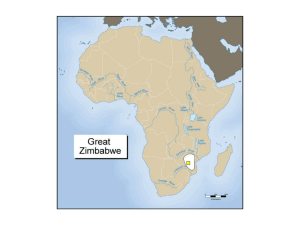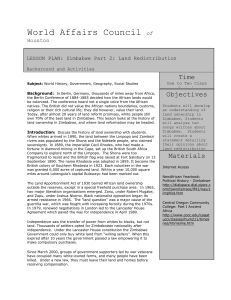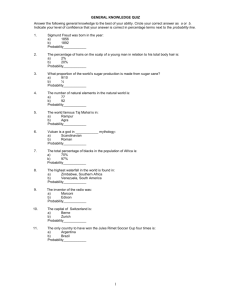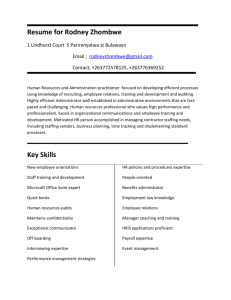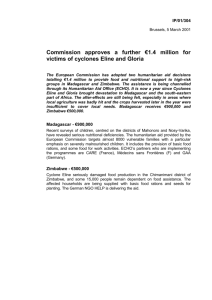Marketing environment is defined as forces and actors that affect the
advertisement
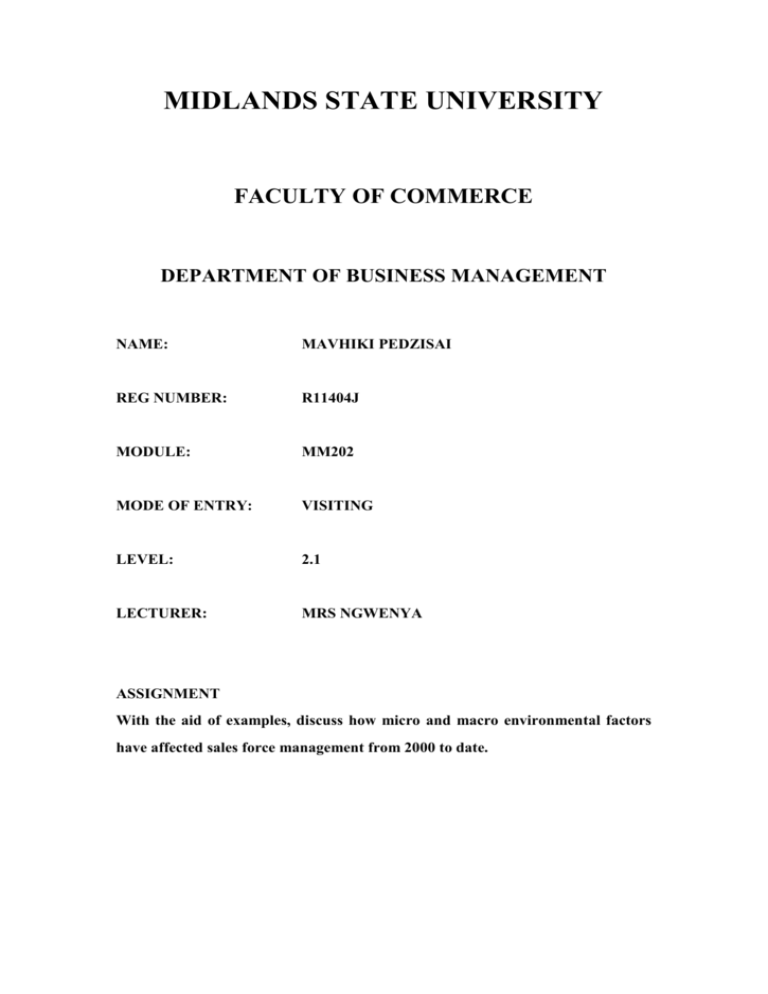
MIDLANDS STATE UNIVERSITY FACULTY OF COMMERCE DEPARTMENT OF BUSINESS MANAGEMENT NAME: MAVHIKI PEDZISAI REG NUMBER: R11404J MODULE: MM202 MODE OF ENTRY: VISITING LEVEL: 2.1 LECTURER: MRS NGWENYA ASSIGNMENT With the aid of examples, discuss how micro and macro environmental factors have affected sales force management from 2000 to date. Marketing environment is defined as forces and actors that affect the company’s ability to develop and maintain successful transaction and lasting relationships with its target market. According to Woodruffe (1995) there are two environments of business which are............ This write up is going to discuss how the micro and macro environmental factors have impacted the sales force management from 2000 to date in Zimbabwe. Salesforce is the group of employees involved in the selling process. Salesforce management is implemented to manage company’s interactions with customers, clients and sales prospect. Since year 2000 macro – environment was not conducive for a number of firms in the country. The macro-environment consists of the factor that salesforce has no control over such forces are depicted by the PESTELI frame where: P - Political factors E - Economics factors S - Social T - Technological E - Ecological L - Legal I - Interaction Some these forces threatened the viability of a number of firms in the country especially between year 2000 and 2003. Between this period there was political unrest or instability which its adverse effects were so disastrous on all business activities. Kotler (1994) argues that marketing decisions are affected by the political environment. In year 2001 there was land invasion. Scores of ruling party supporters forcibly entered vast tracts of commercial agricultural land belonging to mostly white commercial farmers. This weakened bilateral and unilateral relationship of the country with other countries, in the European Union. The image of the country at the world market was bad to an extent that the exports of the country faced low demand.1mark This was a challenge to the salesforce since buyers for exports were no where to be found. It was really difficult to forecast the sales due to such poor relationships. Political philosophies such as the indigenous programme meant to empower the black people through land reform and having 51% shares in foreign companies disrupted production and exports. A number of companies scale down operations due to the indigenisation programme. A decrease in exports therefore means lack of funds to the sales force. Lack of funds for travel, advertising impacted greatly on the sales volume of companies like Hippo Valley Estates Limited2marks. Such processes like order management became difficult with customers in other countries like Namibia. Since year 2000, the economic factors affected the sales force greatly. Jewel (2000) says the economic factors consists of such factors as government policy, interest rates, taxation level, inflation level, disposable income and the exchange rate. The recession which Zimbabwe experienced between year 2000 and 2009 saw costs of borrowing increasing to an extent that investment fall. A fall in investment further fuelled problem as output declined greatly. Companies like OK Zimbabwe, TM, Nyore-Nyore between this period were operating below capacity (below 40% capacity). OK Grand Challenge for example was temporarily stopped between??????????. The company interactions with customers of clients was affected. High levels of inflation which reached billions percent reduced demand for the products. People’s incomes were eroded by inflation and direct tax in the country. Products faced a decrease in demand and money for advertising through the media Newspapers, radio was not available. 1mark Sales force management process includes training, information technology, control, coaching. All these were not done between this period due to lack of funds. Interest rates were so high such that borrowing was so difficult. Companies in Zimbabwe could not manage to invest in modern technology. OK for example could not manage to invest in Bar Code readers. Workshops for training workers on good customer care were suspended. There was no funds as well to educate customers on new products launched. All these augment the problem of poor customer relationships. 1mark Shortage of foreign currency in Zimbabwe saw a number of companies like Triangle Private Limited failing to automate its systems. This caused lack of proper communication between departments like Marketing department, sales department, Human resource 1mark. The end result was to irritate????? customers as all these departments contact the same customer for the same purpose. It was difficult due to lack of firms in Zimbabwe to fully integrate departments due to lack of money. The revolutionary changes in technology between 2000 and 2012 contributed a lot in salesforce management in the country. According to Woodruffe (1995:67) “Many services have arisen directly from advances in technology, computerised, training or customer purpose, even computer dating. The use of bar-code readers in Supermarkets like OK Zimbabwe is a result of technological developments. The use of the internet to contact buyers is a result of these changes. E-selling and Teleselling was unaffordable by firms in Zimbabwe. This was because the country was in recession. Companies could not afford make investments in modern technology. As of now the sales force can do their adverts through the internet. A sales person in Zimbabwe can discuss with a customer in Dubai on products on offer. 2marksTransport costs, time are saved. Delivery of the products is also sped. It is worth noting that the sales force can do it adverts on the internet. Furthermore company need to do much investment in new technology if it wants to be in good relationship with its customers since we are living in a world of technological competition. This also make work of the sales force easy. Kotler (1994:698) argues that “electronic mail allowed the sales reps to rapidly receive and send messages to others.” Various business forms such as territory work plans and sales call reports could be filled out faster and sent electronically. Economic downturn in Zimbabwe could not allow that. There was no such funds in Zimbabwe. The legal environment focuses on legislation as the regulating institution promulgating and enforcing law, rules, statutory enactments like licencing of shops, company registration requirements and procedures, devaluation, revaluation of currency and export procedures (Woodruffe 1995). Jewel (1995”98) argues that legislation places a constraint, on business, limiting what it can do or compelling to undertake actions that would not otherwise perform. Legal constraints adds to costs of operation. Between year 2000 and 2009, devaluation of the currency erode profits of the company. Companies capability to hire / employ qualified sales force was reduced. This greatly affects the control process for establishing standards, measuring actual performance, comparing measured performance against established standards and taking corrective action. 2marksThe sales managers could not well adjust their actions based on overall process The concern by the government for the companies to protect the natural environment contributed much to costs of production. According to Jewel (1992) the natural environment is the environment from which a firm gets its resources. The government of Zimbabwe encouraged companies in the country to identify whether the resources they tape are renewable or non-renewable and use sustainable means of taping them. Companies in Zimbabwe were charged high corporate tax, carbon tax and were given pollution quota. Within the period, decrease in outputs, leads to shortage of funds to deploy the sales forces strategically in order to push sales. 1markKotler (1995) says “alack of funds cause poor remuneration to sales representatives.” The micro environmental factors also affected the sales force management from 2000 to date in Zimbabwe. Woodruffe (1995) view the micro-environment as the internal environment of the organisation. The internal environment is comprised of top management, middle management, workers’ committee, organisational resource, business, management decisions, customers, suppliers and distributor. The major challenge which was encountered by a number of firms like Unilever is lack of experienced qualified personnel. Qualified personnel move to other countries like South Africa, Australia for greener pastures. Staffing organisations with right personnel within the period was do difficult. Recruitment and selection of employees (sales force) were also affected by lack of money. Training and development of marketers were no longer carried out. Workers sales force motivation was so low because of low remuneration. It was also difficult to find distributors of products. Within the period there was high inflation and fuel was a problem in the country. Though the marketing environment was not conducive between year 2000 to 2009 Feb....., the economic activities improved significantly due to dollarisation. The political marriage of thee major parties saw the micro and macro – environment improving. This is the right time for sales force to market the products effectively and efficiently. 2marks REFERENCES Woodruffe, H. (1995) Service Marketing: London: Pitman. Kotler, P. (1994) Marketing Management: New Jersey: Prentice Hall. Engel, F.J. et al (1991) Promotional Strategy: Managing the Communication Process. New York: IRWIN. Jewel, B. (2000) Business Studies: London: Longman.2marks 15/30

